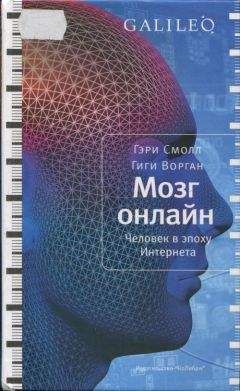66. Green C. S., Bavelier D. Action video game modifies visual selective attention. Nature 2003; 423:534-537
67. Szajlarski J.P., Holland S.K., Schmithorst V. J., Byars A. W. fMRI study of language lateralization in children and adults. Human Brain Mapping 2006; 27:202-212
68. Small G., Vorgan G. The Longevity Bible. Hyperion, New York, 2006
69. Czaja S. J., Charness N., Fisk A. D., et al. Factors predicting the use of technolog у: Findings from the Center for Research and Education on Aging and Technology Enhancement (CREATE). Psychology and Aging 2006; 21:333–352, www.pubmedcentral.nih.gov/articlerender.fcgi?tool=pubmed&pubmedid=16768579
70. Fox S. Digital divisions. Pew Internet & American Life Project. October 5, 2005, www.pewinternet.org/pdfs/PIP_Digital_Divisions_Oct_5_2005.pdf
71. Cohen G. D. The Mature Mind: The Positive Power of the Aging Brain. Basic Books, New York, 2006
72. Cabeza R., Daselaar S. M., Dolcos F., et al. Taskindependent and task-specific age effects on brain activity during working memory, visual attention and episodic retrieval. Cerebral Cortex 2004; 14:364-375
73. Liu Y., Yu C., Liang М., et al. Whole brain functional connectivity in the early blind. Brain 2007; 130: 2085-2096
74. Théoret Merabet L, Pascual-Leone A. Behavioral and neuroplastic changes in the blind: Evidence for functionally rel— evant cross-modal interactions. Journal de Physiologie (Paris) 2004; 98:221-233
75. Burton H., McLaren D.G. Vi— sual cortex activation in late-onset, Braille naive blind individuals: An fMRI study during semantic and phonological tasks with heard words. Neuroscience Letters 2006; 392:38-42
76. Willis S.L, Tennstedt S.L, Marsiske М., et al. Long-term effects of cognitive training on everyday functional outcomes in older adults. Journal of the American Medical Association 2006; 296:2805-2814
77. Velanova K., Lustig С., Jacoby L.L., Buckner R. L. Evidence for frontally mediated controlled processing differences in older adults. Cerebral Cortex 2006; 17:1033-1046
78. Bartzokis G., Lu P.H., Geschwind D. H., et al. Apolipoprotein E genotype and age-related myelin breakdown in healthy individuals: implications for cognitive decline and dementia. Archives of General Psychiatry 2006; 63:63-72
79. Cabeza R., Anderson N. D., Locantore J. K., McIntosh A. R. Aging gracefully: compensatory brain activity in high-performing older adults. Neuroimage 2002; 17: 1394-1402
80. Helson R., Soto C. J. Up and down in middle age: monotonic and nonmonotonic changes in roles, status, and personality. Journal of Personality and Social Psychology 2005; 89:194-204
81. U.S. Census Bureau Resident Population Estimates of the United States by Age and Sex, http://www.census.gov/population/estimates/nation/intfile2-1.txt
Глава 3. Зависимость от технологий
82. Ng B.D., Wiemer-Hastings P. Addiction to the Internet and online gaming. Cyberpsychology & Behavior 2005; 8:110-113
83. Di Chiara G., Bassareo V. Reward system and addiction: What dopamine does and doesn’t do. Current Opinion in Pharmacology 2007; 7:69-76
84. Rau P.-LP., Peng S.-Y., Yang C.-C. Time distortion for expert and novice online game players. Cyberpsychology & Behavior 2006; 9:396–403.
85. Nestler E. J., Carlezon W. A. The mesolimbic dopamine reward circuit in depression. Bio— logical Psychiatry 2006; 59:1151-1159
86. Kalivas P. W., Volkow N. D. The neural basis of addiction: A pathology of motivation and choice. American Journal of Psychiatry 2005; 162:1403-1413
87. Worker fired over visit to adult chat room sues IBM. Los Angeles Times (Associated Press). February 19, 2007
88. Craig S., Zuckerman G. BlackBerry addicts also can’t resist this little game. The Wall Street Journal. February 17, 2007
89. Associated Press. Stanford University study warns of Internet Addiction, http://abclocal.go.com/kabc/story?section=local&id=4679518
90. Kanwal N., Anand A.P. Internet addiction in students: A cause of concern. Cyberpsycholog у & Behavior 2003; 6:653-656
91. Goldman D., Orisci G., Ducci F. The genetics of addictions: uncovering the genes. Nature Review Genetics 2005; 6:521-532
92. Leung L. Net-generation attributes and seductive properties of the Internet as predictors of online activitiesand Internet addiction. Cyberpsychology & Behavior 2004; 7:333-347
93. Pham A. Gaming junkies get no diagnosis. Los Angeles Times. June 28, 2007
94. Beard K. W. Internet addiction. A review of current assessment techniques and potential assessment questions. Cyberpsychology & Behavior 2005; 8:7-15
95. Hakala P. T., Rimpela A. H., Saarni L. A., Salminen J. J. Frequent computer-related activities increase the risk
of neck-shoulder and low back pain in adolescents. European Journal of Public Health 2006; 16:536-541
96. Beard K. W. Cyberpsychology & Behavior 2005; 8:7-15
97. Reuters. Twelve-step program aims to cure e-mail addiction, www.reuters.com/article/internetNews/idUSN1943527720070220
98. Rau P.P., Peng S., Yang C. Time distortion for expert and novice online game players. Cyberpsycholog у & Behavior 2006; 9:396—403
99. Lenhart A. Social networking websites and teens: An overview. Pew Internet & American Life Project. January 3, 2007, www.pewinternet.org/pdfs/PIP_SNS_Data_Memo_Jan_2007.pdf
100. Rau et al. Cyberpsychology & Behavior 2006; 9: 396-403
101. Griffiths M. D., Davies M. N. O., Chappell D. Demographic factors and playing variables in online computer gaming. Cyberpsychology & Behavior 2004; 4:479-487
102. Alter A. Is this man cheating on his wife? The Wall Street Journal. August 10, 2007
103. Spink A., Jansen B.J. Web Search: Public Searching of the Web. Berlin: Springer-Verlag, 2004
104. Maltz W., Maltz L The Porn Trap: The Essential Guide to Overcoming Problems Caused by Pornography. HarperCollins, New York, NY, 2008
105. Spink A., Ozmutlu H.C., Lorence D.P. Web searching for sexual information: an exploratory study. Information Processing and Management 2004; 40:113-123
106. Dun and Bradstreet Survey. D&B study shows seven out of 10 U.S. small businesses now have Internet access. May 25, 2000, www.dnb.com/newsview/0500news8.htm
107. Cooper A., Safir M. P., Rosenmann A. Workplace worries: A preliminary look at online sexual activities at the office — emerging issues for clinicians and employers. Cyberpsychology & Behavior 2006: 9:22-29
108. Lorenz V. C., Politzer R. M. Yaffee R. A. Final report of the Task Force on Gambling Addiction in Maryland, www.nyu.edu/its/statistics/D0cs/task_force_4.html
109. Ackman D. Why pick on Internet gambling? Los Angeles Times. October 29, 2006, www.latimes.com/news/opinion/la-op-ackman290ct29,0,656569.story?coll=la-opinion-rightrail
110. Unlawful Internet Gambling Enforcement Act of 2006, www.techlawjournal.com/cong109/bills/house/gambling/20060929.asp
111. George Ladd and Nancy Petry of the University of Connecticut: Ladd GT, Petry NM. Disordered gambling among university-based medical and dental patients: A focus on Internet gambling. Psychology of Addictive Behaviors 2002:16:76-79
112. Dodd M. L, Klos K. J., Bower J. H., et al. Pathological gambling caused by drugs used to treat Parkinson disease. Archives of Neurolog у 2005; 62:1377-1381
113. Ransom I. Chinese boot camps tackle Internet addiction. International Herald Tribune. March 12, 2007, www.iht.c0m/articles/2007/03/12/business/addicts.php.
Глава 4. Технологии и поведение: СДВГ, дети индиго и другие аномалии
114. Tup Р. А., O’Kane G., Wingfield A. Distraction by competing speech in young and older adult listeners. Psychology and Aging 2002; 17:453-467
115. American Psychiatric Association. Diagnostic and Statistical Manual for Mental Disorders DSM-IV-TR, Fourth Edition (text revision). Washington, DC, American Psychiatric Association. 2000
116. Polanczyk G., Rohde LA. Epidemiology of attentiondeficit/hyperactivity disorder across the lifespan. Current Opinion in Psychiatry 2007; 20:386-392
117. Chan P. A., Rabinowitz T. A cross-sectional analysis of video games and attention deficit hyperactivity disorders symptoms in adolescents. Annals of General Psychiatry 2006; 5:16
118. Yen J. Y., Ко C. H., Yen C. F., Wu H. Y., Yang M. J. The comorbid psychiatric symptoms of Internet addiction: Attention deficit and hyperactivity disorder (ADHD), depression, social phobia, and hostility. Journal of Adolescent Health 2007; 41:93-98
119. Ha J. H., Yoo H. J., Cho I. H., Chin R, Shin D., Kim J. H Psychiatric comorbidity assessed in Korean children and adolescents who screen positive for Internet addiction. Journal of Clinical Psychiatry 2006; 67:821-826
120. Christakis D. A., Zimmerman F. J., DiGuiseppe D. L, McCarty C. A. Early television exposure and subsequent attentional problems in children. Pediatrics 2004; 113:707-713
121. American Academy of Pediatrics. Children, adolescents, and television. Pediatrics 2001; 107:423-426
122. Vandewater E. A., Rideout V. J., Wartella E. A., Huang X., Lee J. H., Shim M. S. Digital childhood: Electronic media and technology use among infants, toddlers, and preschoolers. Pediatrics 2007; 119(5):e1006-1015, http://pediatrics.aappublications.org/cgi/content/full/119/5/e1006
123. Spencer T. J., Biederman J., Mick E. Attentiondeficit/hyperactivity disorder: diagnosis, lifespan, comorbidities, and neurobiolog y. Journal of Pediatric Psychology 2007; 32:631-642
124. Eppinger B., Kray J., Mecklinger A., John O. Age differences in task switching and response monitoring: evidence from ERPs. Biological Psychiatry 2007; 75:52-67
125. Rubinstein J. S., Meyer D. E., Evans J. E. Executive control of cognitive processes in task switching. Journal of Experimental Psychology and Human Perceptual Performance 2001; 27:763-797
126. Thompson C. Meet the life hackers. The New York Times. October 16, 2005
127. Allen K, Blascovich J. Effects of music on cardiovascular reactivity among surgeons. Journal of the American Medical Association 1994; 272:882-884
128. Carroll L Indigo Children. Hay House, London, 1999
129. McPartland J., Klin A. Asperger’s syndrome. Adolescent Medicine Clinics 2006; 17:771-788
130. Baum S. M., Olenchak F. R., Owen S. V. Gifted students with attention deficits: Fact and/or fiction? Or, can we see the forest for the trees? Gifted Child Quarterly 1998; 42:96-104
131. Healey D., Rucklidge J. J. An exploration into the creative abilities of children with ADHD. Journal of Attention Disorders 2005; 8:88-95
132. Shaw P., Greenstein D., Lerch J., et al. Intellectual ability and cortical development in children and adolescents. Nature 2006; 440:676
133. Whitehouse M. Mind and matter. Is an economist qualified to solve puzzle of autism? The Wall Street Journal. February 27, 2007. Waldman M. Does television cause autism? www.johnson.cornell.edu/faculty/profiles/waldman/autpaper.html
134. Williams D. L, Goldstein G., Minshew N. J. Neuropsychologic functioning in children with autism: Further evidence for disordered complex informationprocessing. Child Neuropsycholog y 2006:12:279-298
Koshino H., Капа R. K., Keller T. A., Cherkassky V. L, Minshew N. J., Just M. A. fMRI investigation of working memory for faces in autism: Visual coding and underconnectivity with frontal areas. Cerebral Cortex 2008; 18:289-300
135. Nacewicz B. M., Dalton K. M., Johnstone Т., et al. Amygdala volume and nonverbal social impairment in adolescent and adult males with autism. Archives of General Psychiatry 2006; 63:1417-1428
136. Dalton K. M., Nacewicz B. M., Alexander A. L, Davidson R.J. Gaze-fixation, brain activation, and amygdala volume in unaffected siblings of individuals with autism. Biological Psychiatry 2007; 61:512-520
137. Mathiak K., Weber R. Toward brain correlates of natural behavior: fMRI during violent video games. Human Brain Mapping 2006; 27:948-956
138. Mason M. Is it disease or delusion? U.S. takes on a dilemma. The New York Times. October 24, 2006
139. Small G. W., Borus J. F. Outbreak of illness in a school chorus: Toxic poisoning or mass hysteria? New England Journal of Medicine 1983; 308:632-635
140. Vuilleumier P. Hysterical conversion and brain function. Progress in Brain Research 2005; 150:309-329
141. Small G.W., Borus J.F. The influence of newspaper reports on outbreaks of mass hysteria. Psychiatric Quarterly 1987; 58:269-278
142. Alao A. O., Soderberg М., Pohl E. L, Alao A. L Cybersuicide: Review of the role of the internet on suicide. Cyberpsychology and Behavior 2006; 9:489-493
143. Rajagopal S. Suicide pacts and the Internet. British Medical Journal 2004; 4:329:1298-1299
144. Angst J. Major depression in 1998: Are we providing optimal therapy? Journal of Clinical Psychiatry 1999:60 Suppl 6:5-9
145. Cacioppo J. T., Hughes M. E., Waite L. J., Hawkley L. C., Thisted R. A. Loneliness as a specific risk factor for depressive symptoms: Cross-sectional and longitudinal analyses. Psychology and Aging 2006; 21:140-151
146. Czaja S. J., Chamess N., Fisk A. D., et al. Factors predicting the use of technology: Findings from the Center for Research and Education on Aging and Technology Enhancement (CREATE). Psycholog у and Aging 2006; 21:333-352
147. Lubman D. I., Yücel М., Pantelis C. Addiction, a condition of compulsive behaviour? Neuroimaging and neuropsychological evidence of inhibitory dysregulation. Addiction 2004; 99:1491-1502




